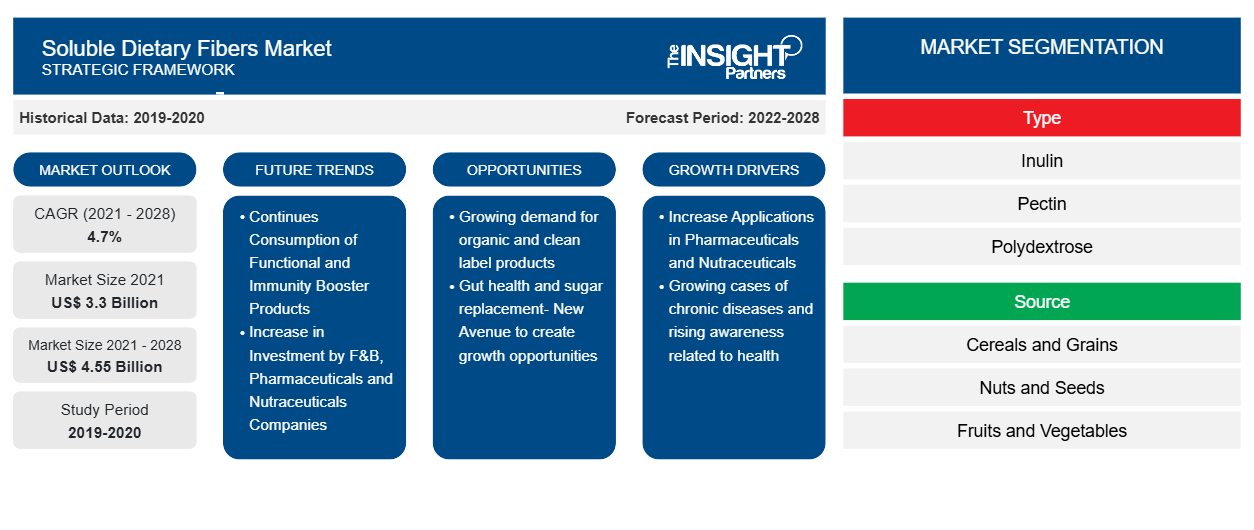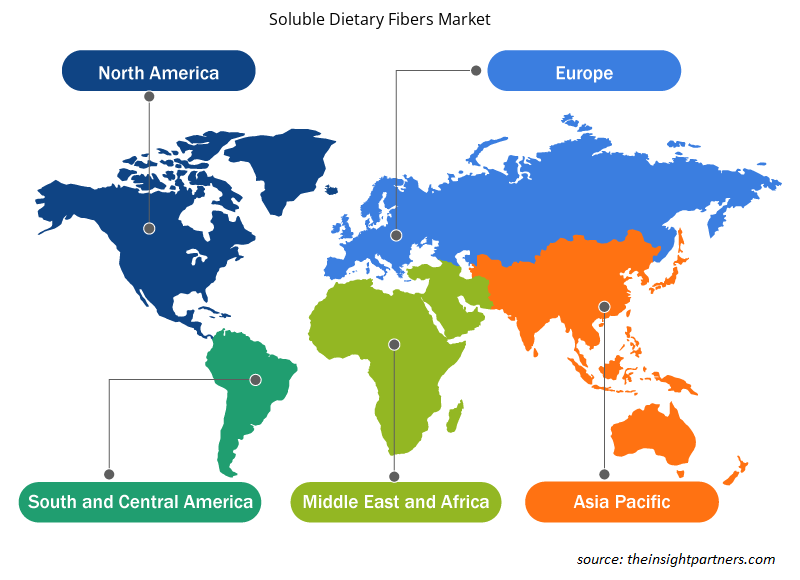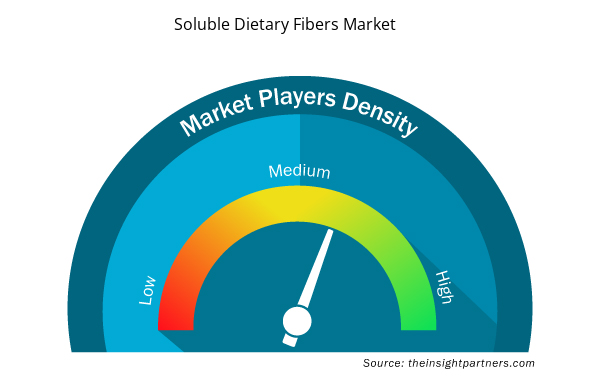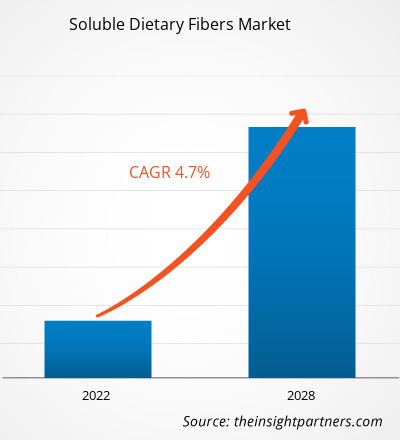The soluble dietary fibers market is expected to grow from US$ 3,301.31 million in 2021 to US$ 4,546.47 million by 2028; it estimated to grow at a CAGR of 4.7% from 2021 to 2028.
Soluble dietary fibers are defined as the fibers that display dispersibility in water to create a gel-like material. These fibers produce viscous gels in the gastrointestinal tract and possess the capability to slow down the process of passing food from the stomach to the intestine. Such type of fibers is significantly sourced out from fruits and vegetables, legumes, and oats. Soluble dietary fibers helps to promote the colonic health along with bifidobacterial or lactobacillus stimulation in the gut, coronary artery health, as well as lowers lower cholesterol, and glucose levels. Shifting consumer lifestyle along with the rising incorporation of dietary fibers as a functional food ingredient propels the demand for soluble dietary fibers. Additionally, the expanding application base of soluble dietary fibers across various industries, such as food and beverage, pharmaceutical and nutraceutical, and animal feed, is expected to provide impetus for market growth in coming years.
In 2021, Asia Pacific held the largest revenue share of the global soluble dietary fibers market. The high consumption of soluble dietary fibers in Asia Pacific is attributed to rising consciousness toward health and wellness. The presence of a manufacturing hub and the growing demand for soluble dietary fibers from food and beverage processing industries drives the market growth in the region. Additionally, the changing lifestyle of consumers and booming food & beverages industry along with market penetration by global market players are expected to propel the market growth in coming years. In addition, continuous research and development and the growth of pharmaceutical and nutraceutical, animal feed, and other such industries have led to the widespread adoption of soluble dietary fiber in the regional market.
Customize This Report To Suit Your Requirement
You will get customization on any report - free of charge - including parts of this report, or country-level analysis, Excel Data pack, as well as avail great offers and discounts for start-ups & universities
Soluble Dietary Fibers Market: Strategic Insights

- Get Top Key Market Trends of this report.This FREE sample will include data analysis, ranging from market trends to estimates and forecasts.
Customize This Report To Suit Your Requirement
You will get customization on any report - free of charge - including parts of this report, or country-level analysis, Excel Data pack, as well as avail great offers and discounts for start-ups & universities
Soluble Dietary Fibers Market: Strategic Insights

- Get Top Key Market Trends of this report.This FREE sample will include data analysis, ranging from market trends to estimates and forecasts.
Impact of COVID-19 Pandemic on Soluble Dietary Fibers Market
The ongoing COVID-19 pandemic has drastically altered the status of the food & beverages sector and negatively impacted the growth of the soluble dietary fibers market. The implementation of measures to combat the spread of the virus has aggravated the situation and affected the growth of several industrial sectors. The market has been impacted by the sudden distortion in operational efficiencies and disruptions in the value chains attributable to the sudden closure of national and international boundaries. Disruptions in terms of sourcing of raw materials from suppliers and temporarily closures of manufacturing bases due to indefinite lockdowns and temporary quarantines have impacted the growth of the market during the pandemic. However, as much as the pandemic have affected the supply chain operations, the pandemic has generated the need for healthy living among the consumers, due to which, the consumers have shifted their attention toward nutritional food products. For instance, as per an article published by Nutrition Insight in June 2020, the pandemic has created growth opportunities for the dietary fiber market with the growing inclination toward organic, natural, and clean label products, along with strong focus on gut health and sugar replacements. As per the World Health Organization (WHO) health guidelines, it is imperative to consume 25 g dietary fibers per day to build immunity against microbes. Soluble fibers obtained from oats, barley, peas, apples, citrus fruits, and potatoes, as well as chemically engineered sulfated glucans, possess the potential to mitigate constipation and show strong antiviral capabilities. Further, as per the International Scientific Association for Pro- and Prebiotics (ISAPP), inulin and oligofructose are categorized as significant types of plant-based, prebiotic soluble dietary fibers, which possesses the capability to promote gut health, essential at the present pandemic times. For instance, as per an article published by FoodIngredientsFirst, consumers are actively involved in consuming organic chicory root fiber. This fiber is composed of soluble inulin fiber, and it helps to promote gut health, mental well-being, and immunity. Hence, with the growing trend of consumption of functional and immunity-booster products, the demand for soluble dietary fibers is expected to flourish in post-pandemic times. Further, as the economies are planning to revive their operations, the demand for soluble dietary fibers is expected to rise globally. The expanding demand for soluble dietary fibers across food & beverages, pharmaceuticals and nutraceuticals, animal feed, and other industries, along with significant investment by prominent manufacturers, is expected to drive the soluble dietary fibers market.
Market Insights
Increasing Applications of Soluble Dietary Fibers in Pharmaceuticals and Nutraceuticals
Soluble dietary fibers are used as an additive to foods, and they also promote the colonic health, along with bifidobacterial or lactobacillus stimulation in the gut, coronary artery health, lowers cholesterol, and glucose metabolism. Moreover, soluble dietary fibers contribute to weight management and reduce the risk of cardiovascular diseases. Water-soluble dietary fiber is considered as one of the significant forms of dietary fibers. It is composed of inulin, beta-glucan, polydextrose, pectin, fructooligosaccharides, galactooligosaccharides, and corn fiber, which helps promote the nutritional profile of the food and beverage product added.
For instance, Roquette is involved in offering non-viscous soluble fiber under its brand “NUTRIOSE” for food, pharmaceutical and nutraceutical industries. NUTRIOSE is produced from cereals such as wheat and corn and provides efficient digestive tolerance. Similarly, Steadfast Nutrition, which is a premium sports and wellness nutrition company, is involved in offering soluble dietary fiber based dietary supplement powder under the brand, Tri Fiber. The presence of soluble dietary fiber helps maintain a healthy intestine, along with balanced blood glucose levels and serum lipids. Moreover, the product helps to manage the appetite hormones, enhances the bowel movement, and manages triglycerides levels in the body to improve the lipid profile by exercising a control over cholesterol levels. The improved effects of resistant maltodextrin are identified by Foods for Specified Health Use (FOSHU). The product can be consumed by office goers, weight watchers, athletes & fitness enthusiasts, and patients. Similarly, Benefiber and Metamucil are over the counter (OTC) soluble fiber supplements. Benefiber is approved by the Food and Drug Administration (FDA) as a dietary fiber supplement, and it is composed of wheat dextrin as an active ingredient. It helps to absorb water in the intestinal tract along with stimulating peristalsis or the repetitive contraction and relaxation of intestinal muscle. Metamucil is prepared from psyllium husks, obtained from seeds of an Indian herb, Plantago ovata. The growing focus on health, along with increasing consciousness toward health benefits offered soluble dietary fibers and increasing instances of chronic diseases, has motivated the manufacturers to produce nutraceutical and pharmaceutical products based upon soluble dietary fibers, which is expected to propel the demand for soluble dietary fibers in global market.
Type Insights
Based on type, the soluble dietary fibers market is segmented into inulin, pectin, polydextrose, beta-glucan, and others. In 2021, the inulin segment is dominating the market. Inulin is a soluble fiber obtained from many plants. Various types of fruits, vegetables, and herbs, including wheat, onions, garlic, bananas, leeks, artichokes, chicory roots, and asparagus, are used to extract inulin. For medicinal use, inulin is commonly obtained from chicory roots. Inulin is used for weight loss, constipation, diarrhea, and diabetes. It is also used as a tool for therapeutic drug delivery. Inulin supplements are available in capsule and powder forms. Inulin is used in a variety of products, including dairy products, bread, cereal bars, healthcare nutrition, newborn nutrition, drinks, confectionery, ice cream, and savory foods. Many food manufacturers add inulin to processed products to boost the prebiotic content of foods, replace fat and sugar in foods, and improve the health benefits of foods as it is beneficial for gut health. Inulin improves taste and texture. At high concentration, inulin can alter the texture profile of products because of its physico-chemical significance.
Source Insights
Based on source, the soluble dietary fibers market is segmented into cereals and grains, fruits and vegetables, and others. In 2021, the cereals and grains segment is dominating the market. Different types of cereals and grains such as wheat, barley, oat, rye, and corn, are used as a source to produce soluble dietary fibers. Wheat bran, the outer layer of the whole wheat grain, is an excellent source of prebiotics. Wheat bran is helpful to reduce digestive problems such as gas, cramping, and abdominal pain. Oats consist of high amount of soluble fibers. Oats are used to make breakfast cereals, breads, scones, flapjacks, or fruit crumbles. They contain beta- glucan, which helps to control blood sugar level. Barley is another cereal crop with very high amount of dietary fibers, particularly the soluble fiber portion. Barley contains about 3.5–5.9% of the soluble fiber beta- glucan.
Application Insights
Based on application, the soluble dietary fibers market is segmented into food and beverages, animal nutrition, pharmaceuticals and nutraceuticals, and others. In 2021, the food and beverages segment is dominating the market. There are various types of soluble dietary fibers used in the food & beverages industry. These soluble dietary fibers are used as an ingredient in many applications including dairy, bakery, protein bars, cereal bars, beverages, confectionery, ice cream, desserts, soft drinks, bread, and cereal based products. Soluble dietary fibers such as inulin, polydextrose, pectin, and dextrins are used to replace fat and sugar in foods. Being colorless, inulin can be used in many food products without affecting their appearance, texture, or flavor. Pectin is utilized as a thickening agent in the commercial production of jellies, jams, and marmalades. Soluble fibers are used in food to improve taste and texture while also providing many health benefits.
A few major key players operating in the soluble dietary fibers market are Beneo Gmbh; Roquette Frères; Ingredion Incorporated; Tate & Lyle Plc; and Cargill, Incorporated. These market players are highly focusing on the development of high quality and innovative product offerings.
Soluble Dietary Fibers Market Regional Insights
The regional trends and factors influencing the Soluble Dietary Fibers Market throughout the forecast period have been thoroughly explained by the analysts at Insight Partners. This section also discusses Soluble Dietary Fibers Market segments and geography across North America, Europe, Asia Pacific, Middle East and Africa, and South and Central America.

- Get the Regional Specific Data for Soluble Dietary Fibers Market
Soluble Dietary Fibers Market Report Scope
| Report Attribute | Details |
|---|---|
| Market size in 2021 | US$ 3.3 Billion |
| Market Size by 2028 | US$ 4.55 Billion |
| Global CAGR (2021 - 2028) | 4.7% |
| Historical Data | 2019-2020 |
| Forecast period | 2022-2028 |
| Segments Covered |
By Type
|
| Regions and Countries Covered | North America
|
| Market leaders and key company profiles |
Soluble Dietary Fibers Market Players Density: Understanding Its Impact on Business Dynamics
The Soluble Dietary Fibers Market market is growing rapidly, driven by increasing end-user demand due to factors such as evolving consumer preferences, technological advancements, and greater awareness of the product's benefits. As demand rises, businesses are expanding their offerings, innovating to meet consumer needs, and capitalizing on emerging trends, which further fuels market growth.
Market players density refers to the distribution of firms or companies operating within a particular market or industry. It indicates how many competitors (market players) are present in a given market space relative to its size or total market value.
Major Companies operating in the Soluble Dietary Fibers Market are:
- Cargill, Incorporated
- Kerry Group
- Ingredion Incorporated
- Nexira
- Roquette Frères
Disclaimer: The companies listed above are not ranked in any particular order.

- Get the Soluble Dietary Fibers Market top key players overview
Report Spotlights
- Progressive industry trends in the soluble dietary fibers market to help players develop effective long-term strategies
- Business growth strategies adopted by developed and developing markets
- Quantitative analysis of the soluble dietary fibers market from 2019 to 2028
- Estimation of global demand for soluble dietary fibers
- PEST analysis to illustrate the efficacy of buyers and suppliers operating in the industry
- Recent developments to understand the competitive market scenario
- Market trends and outlook as well as factors driving and restraining the growth of the soluble dietary fibers market
- Assistance in decision-making process by highlighting market strategies that underpin commercial interest, leading to the market growth
- Detailed overview and segmentation of the market, as well as the soluble dietary fibers industry dynamics
- Size of the soluble dietary fibers market in various regions with promising growth opportunities
Soluble Dietary Fibers Market, by Type
- Inulin
- Pectin
- Polydextrose
- Beta-glucan
- Others
Soluble Dietary Fibers Market, by Source
- Cereals and Grains
- Fruits and Vegetables
- Others
Soluble Dietary Fibers Market, by Application
- Food and Beverages
- Animal Nutrition
- Pharmaceuticals and Nutraceuticals
- Others
Company Profiles
- Cargill, Incorporated
- Kerry Group
- Ingredion Incorporated
- Nexira
- Roquette Frères
- ADM
- Tate And Lyle PLC
- IFF Nutrition & Biosciences
- Beneo GMBH
- Cosucra
- Historical Analysis (2 Years), Base Year, Forecast (7 Years) with CAGR
- PEST and SWOT Analysis
- Market Size Value / Volume - Global, Regional, Country
- Industry and Competitive Landscape
- Excel Dataset



Report Coverage
Revenue forecast, Company Analysis, Industry landscape, Growth factors, and Trends

Segment Covered
Type, Source, Application and Geography

Regional Scope
North America, Europe, Asia Pacific, Middle East & Africa, South & Central America

Country Scope
Argentina, Australia, Brazil, Canada, China, France, Germany, India, Italy, Japan, Mexico, Russian Federation, Saudi Arabia, South Africa, South Korea, United Arab Emirates, United Kingdom, United States
Frequently Asked Questions
The ongoing pandemic has drastically altered the status of the food & beverages sector and negatively impacted the growth of the soluble dietary fibers market. The market has been impacted by the sudden distortion in operational efficiencies and disruptions in the value chains attributable to the sudden closure of national and international boundaries. Disruptions in terms of sourcing of raw materials from suppliers and temporarily closures of manufacturing bases due to indefinite lockdowns and temporary quarantines have impacted the growth of the market during the pandemic. However, due to the pandemic the consumers have shifted their attention toward consumption of functional and immunity-booster products which is expected to flourish the global soluble dietary fibers market.
Growing demand for soluble dietary fibers as a sugar replacement in beverages and as a prebiotic is the latest trend in soluble dietary fibers market. The use of soluble dietary fiber is rising fairly in beverages and drinks as it shows better dispersibility in water in comparison to insoluble fiber. Additionally, the incorporation of soluble dietary fiber in beverage formulations helps improve the overall physical and chemical properties as the beverage particles get uniformly distributed; enhance the stability; and prevent precipitation and stratification.
The food and beverages segment held the largest share in the global soluble dietary fibers market in 2020. Soluble dietary fibers are extensively used as a vital ingredient in several food and beverage products such as dairy products, bakery and confectionery items, beverages, ice cream and desserts, and cereal based products. Soluble dietary fibers help to promote the overall nutritional profile along with modifying the physiochemical and functional properties of these food products.
Based on type, the soluble dietary fibers market is categorized into inulin, pectin, polydextrose, beta-glucan and others. In 2020, the inulin segment led the market. Inulin is a soluble fiber obtained from many plants. Various types of fruits, vegetables, and herbs, including wheat, onions, garlic, bananas, leeks, artichokes, chicory roots, and asparagus, are used to extract inulin. For medicinal use, inulin is commonly obtained from chicory roots. Inulin is used for weight loss, constipation, diarrhea, and diabetes.
The major players operating in the global soluble dietary fibers market are Cargill, Incorporated; Kerry Group; Ingredion Incorporated; Nexira.; Ingredion Incorporated; Roquette Frères.; ADM; Tate And Lyle PLC; IFF Nutrition & Biosciences; Beneo GMBH and Cosucra.
In 2020, Asia Pacific held the largest revenue share of the global soluble dietary fibers market. The consumption of soluble dietary fibers is high in the region attributable to rising consciousness towards health and wellness. The presence of a manufacturing hub and the growing demand for soluble dietary fibers from food and beverage processing industries are most likely to impact the market's development. Additionally, the changing lifestyle coupled with booming food & beverages industry and market penetration by global market players are altogether expected to contribute for the market growth.
Trends and growth analysis reports related to Food and Beverages : READ MORE..
The List of Companies - Global Soluble Dietary Fibers Market
- Cargill, Incorporated
- Kerry Group
- Ingredion Incorporated
- Nexira
- Roquette Frères
- ADM
- Tate And Lyle PLC
- IFF Nutrition & Biosciences
- Beneo GMBH
- Cosucra

 Get Free Sample For
Get Free Sample For